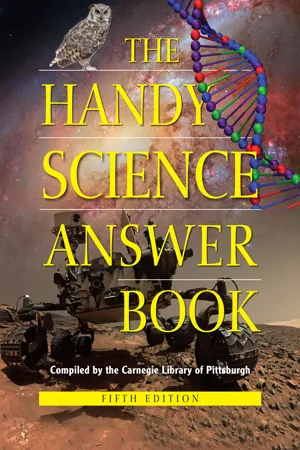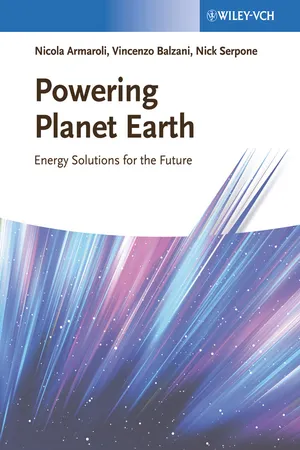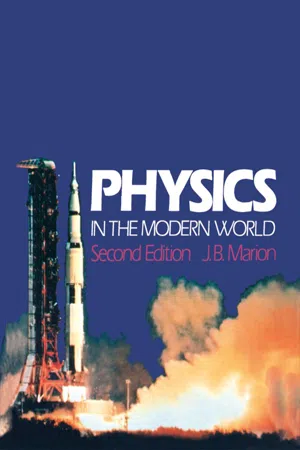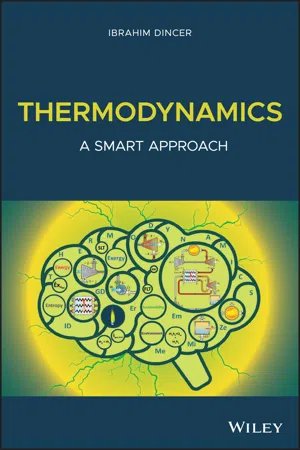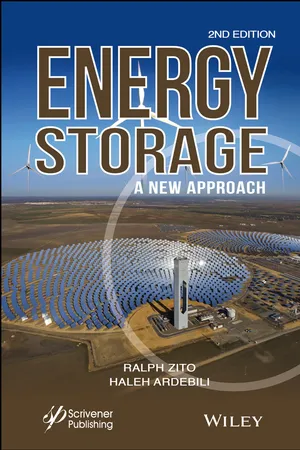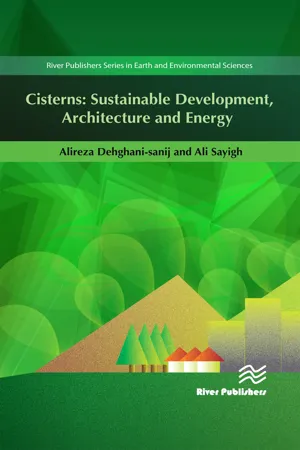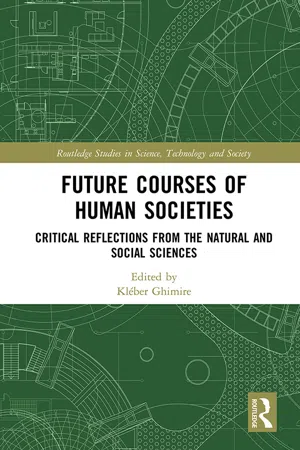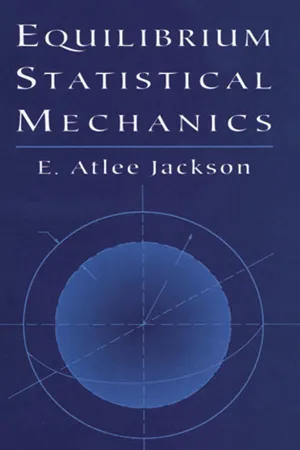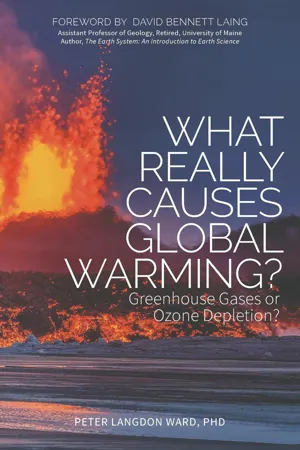Physics
Forms of Energy
Forms of energy refer to the various ways in which energy can manifest, including kinetic energy (energy of motion), potential energy (stored energy), thermal energy (heat), chemical energy (energy stored in chemical bonds), electrical energy, and more. These forms can be converted from one to another, following the principles of conservation of energy.
Written by Perlego with AI-assistance
Related key terms
Related key terms
1 of 4
Related key terms
1 of 3
10 Key excerpts on "Forms of Energy"
- eBook - ePub
- James Bobick, Naomi E. Balaban(Authors)
- 2019(Publication Date)
- Visible Ink Press(Publisher)
Physicists define energy as the capacity to do work. Work is defined as the force required to move an object some distance. Examples of the different kinds of energy are thermal (heat) energy, light (radiant) energy, mechanical energy, electrical energy, and nuclear energy. The law of the conservation of energy states that within an isolated system, energy may be transformed from one form to another, but it cannot be created nor can it be destroyed.What are the two Forms of Energy?The two Forms of Energy are kinetic (working) energy and potential (stored) energy. Kinetic energy is the energy possessed by an object as a result of its motion, while potential energy is the energy possessed (stored) by an object as a result of its position. As an example, a ball sitting on top of a fence has potential energy. When the ball falls off the fence, it has kinetic energy. The potential energy is transformed into kinetic energy. Some examples of different Forms of Energy are:•Chemical energy is a form of potential energy. It is the energy stored in the bonds of atoms and molecules. Some examples of chemical energy are batteries, biomass, petroleum, natural gas, and coal. •Mechanical energy is also a form of potential energy. It is stored in objects by tension. Examples of mechanical energy are compressed springs and stretched rubber bands. •Nuclear energy is energy stored in the nucleus of an atom. Large amounts of energy may be released when the nuclei are combined or split apart. Nuclear energy is a form of potential energy.•Gravitational energy is energy stored in an object’s height. The higher and heavier the object, the more gravitational energy is stored. As an object goes down a hill and picks up speed, the gravitational energy is converted to motion energy. Gravitational energy is also a form of potential energy.•Radiant energy is electromagnetic energy that travels in transverse waves. Light and sunshine are examples of radiant energy. It is a form of kinetic energy. - eBook - ePub
Powering Planet Earth
Energy Solutions for the Future
- Nicola Armaroli, Vincenzo Balzani, Nick Serpone(Authors)
- 2012(Publication Date)
- Wiley-VCH(Publisher)
work .Broadly speaking, the ability to do work manifests itself in many ways; what we define as Forms of Energy go far beyond muscle energy described above. In their diversity, all Forms of Energy have one common feature: they are always the expression of a system that is capable of exerting a force, which can act against another force.We can easily locate seven Forms of Energy, almost all of which we experience daily:1)Thermal energy:radiators that heat our house.2)Chemical energy:natural gas that feeds our gas furnace and/or gas stove.3)Electrical energy:energy that makes electrical appliances work.4)Electromagnetic energy or light:sunlight that makes plants grow in a vase, on a balcony, or on a farm.5)Kinetic energy:energy of a glass bowl falling to the ground (gets broken).6)Gravitational energy:If the glass vase falls from a height of 10 centimeters (about 4 inches) it will likely not break, but if it falls from 2 meters (about 6.5 feet) there’s no hope of saving it.7)Nuclear energy:energy from the atom: difficult to see – we’ll have more to say on this later.The various Forms of Energy can then be converted from one form to another, but not always. For example, we can transform the Sun’s light energy into electricity through a solar panel. However, contrary to what is often thought, we cannot transform nuclear energy directly into electrical energy. Nuclear power plants are nothing more than sophisticated water kettles that convert nuclear energy into thermal energy, which in turn is converted into mechanical energy and then finally into electrical energy. - eBook - ePub
- Jerry Marion(Author)
- 2012(Publication Date)
- Academic Press(Publisher)
7 ENERGY Publisher Summary The total energy of a system remains the same even though energy is changed from one form to another within the system or is exchanged between objects that are part of that system. This chapter focuses on mechanical Forms of Energy. It discusses thermal energy, electric energy, elastic energy, and mass-energy. Work is always done when an object is moved against some resisting force. It discusses the two Forms of Energy: (1) kinetic energy and (2) potential energy. The kinetic energy of an object is proportional to its mass and to the square of its velocity. The gravitational potential energy that can be converted into work depends only on the change in height that the object undergoes. The chapter explains rotational kinetic energy. The importance of the energy concept was not fully understood until the middle of the 19th century. By this time it was realized that energy takes many forms—motional energy, chemical energy, heat energy, electromagnetic energy, and so forth. The great unifying principle that places all of the various Forms of Energy on an equal basis and makes the energy concept of truly universal significance was stated in 1847 by the German physicist Hermann von Helmholtz (1821–1894). Helmholtz’s important contribution was to realize that energy can be converted from one form to another and transferred from one object to another without loss. That is, the total energy of a system remains the same even though energy is changed from one form to another within the system or is exchanged between objects that are part of that system - eBook - ePub
Thermodynamics
A Smart Approach
- Ibrahim Dinçer(Author)
- 2020(Publication Date)
- Wiley(Publisher)
The internal energy can be defined as the sum of the potential and kinetic energies of the molecules or, in a more general description, the summation of all the microscopic Forms of Energy of a system. Internal energy may generally be classified into five different forms of microscopic energies, as shown in Figure 2.4. As shown in the figure, these are the sensible, nuclear, latent, chemical, and possibly other types of energies (such as magnetic). Chemical energy represents the part of the internal energy that is associated with the chemical bonds holding the atoms together to form a molecule. Latent energy is the part of the internal energy that it is stored in the bonds holding the structure of the phase, in other words in order to phase change the system the latent energy must be supplied or removed from the system. Nuclear energy is associated with the energy responsible for holding the material atom nuclear together. Finally, sensible energy, represents the part of the internal energy associated with the kinetic energy of the molecules, where the system temperature is usually a measure of this energy. 2.3 Energy and the Environment One of the most critical challenges affecting the relationship between ourselves and the environment is energy. Anything we do with energy, in terms of production, distribution, conversion, transportation, and consumption determines how much and how severely we can affect our environment. The levels of interactions play a critical role, depending on the sources and systems deployed, and can represent how damaging or healing such interactions with it might be. An example of our damaging interactions with the environment through energy production and utilization is the use of fossil fuels. They are hydrocarbon based fuels and contain both carbon and hydrogen, and greenhouse gases (GHGs) become unavoidable emissions in every process we burn them - eBook - ePub
Energy Storage
A New Approach
- Ralph Zito, Haleh Ardebili(Authors)
- 2019(Publication Date)
- Wiley-Scrivener(Publisher)
The history of the development of physical concepts is not the prime concern here, but some knowledge of their evolution does serve to bring more closely to our attention and scrutiny a better appreciation of terms that we employ daily. Sometimes it is necessary to begin understanding or developing a body of knowledge in order to make certain basic assumptions on an entirely intuitive basis. As scientifically unsatisfying as that may be, it is unavoidable at times. One could draw a weak comparison to plane geometry (Euclid) with regard to its various axioms and the declaration that parallel lines never meet. Even the concept of straight lines is rather intuitive in nature.Perhaps the best definition is that a force is required to change the motion of a body. Many problems arise in finding acceptable definitions for the basic parameters of physical science, namely, the abstract concepts of mass, time, force, and energy. However, we must learn to be satisfied with definitions that leave something to be desired in order to move on toward generating a working body of mechanics that enables us to design and build practical devices that serve our purposes.An interesting definition of energy comes from the Grolier Encyclopedia, which states:Energy can be measured in terms of mechanical work, but because not all Forms of Energy can be converted into useful work, it is more precise to say that the energy of a system changes by an amount equal to the net work done on the system … In classical physics, energy, like work, is considered a scalar quantity; the units of energy are the same as those of work. These units may be ergs, joules, watt-hours, foot-pounds, or foot-poundals, depending on the system of units being used. In modern science, energy and the three components of linear momentum are thought of as different aspects of a single four-dimensional vector quantity, much as time is considered to be one aspect of the four-dimensional space-time continuum … Energy exists in many different forms. The form that bodies in motion possess is called kinetic energy. Energy may be stored in the form of potential energy, as it is in a compressed spring. Chemical systems possess internal energy, which can be converted by various devices into useful work; for example, a fuel such as gasoline can be burned in an engine to propel a vehicle. Heat energy may be absorbed or released when the internal energy of a system changes while work is done on or by the system. (1993) - eBook - ePub
- Justin P. Lomont, Ian C. Stewart(Authors)
- 2013(Publication Date)
- Visible Ink Press(Publisher)
PHYSICAL AND THEORETICAL CHEMISTRY
ENERGY IS EVERYTHING
What is physical chemistry?Physical chemistry is a branch of chemistry primarily concerned with developing a better understanding of the fundamental principles that govern chemical processes. It is an empirical science, meaning that it is based on experimental observations, though it is probably the most closely linked experimental branch of chemistry to developing new theories in chemistry. As the name implies, physical chemistry is intrinsically concerned with topics in physics that are also relevant to the study of chemistry.What is energy?In chemistry, energy serves as the “currency” for making or breaking chemical bonds and moving molecules (or matter) from one place to another.What is potential energy?Potential energy describes all of the nonkinetic energy associated with an object. This energy can be the energy stored in chemical bonds, in a compressed spring, or in a variety of other ways. Another example is gravitational potential energy, like that associated with a ball sitting at the top of a hill. Since there are many types of potential energy, there isn’t a single equation that describes them all. Since the value we assign to potential energy is always inherently described relative to some choice of a reference value, we can only actually measure changes in potential energy in a meaningful way. A closed system can exchange potential energy for kinetic and vice versa, but the total energy must always remain constant. This is stated in the First Law of Thermodynamics, which we’ll get to soon.What is kinetic energy?Kinetic energy is the type of energy associated with the movement of an object. Faster-moving objects have more kinetic energy, and the kinetic energy of an object is related to its mass, m, and velocity, v, by the equation: - eBook - ePub
Cisterns
Sustainable Development, Architecture and Energy
- Alireza Dehghani-sanij, Ali Sayigh(Authors)
- 2022(Publication Date)
- River Publishers(Publisher)
1 ]. So, man’s life has always depended on energy consumption. Changing the food into energy, he sustains his life and does some kind of work.Energy has been defined as the ability to do some work. Work is specified as the force multiplied by the change of distance in line with the force. Energy exists in different forms, the most important of which are as follows [2 ]:- Electrical energy (electricity) is easily transmitted and has many applications like light;
- Mechanical energy which is used in motor-vehicles and agricultural and industrial machines;
- Potential energy like the water behind the dams for generating electricity, irrigation of lands, and supplying water for cities;
- Kinetic energy like the energy of wind to generate electricity or mechanical energy for discharging water from the wells and rivers;
- Chemical energy which is released in chemical reactions, like the energy produced by burning fossil fuels such as oil, natural gas, coal, wood, agricultural residues, waste, and the like;
- Nuclear energy released in a nuclear reaction which is used to produce electricity in power plants;
- Internal energy which is the total energy of an object at its molecular level;
- Heat energy which is transferred from the object with higher heat to the object with lower heat.
The quality of energy varies from one kind to another, i.e. some kind of energies has a better quality like electrical energy, chemical energy, and nuclear energy, whereas ocean’s heat energy and molecular energy have a lower quality [2]. Several factors like the lack of or emerging of new technologies cause changes in the use of energy. Therefore, it can be said that every energy system includes the producing technology and the way it is consumed. The purpose of each energy system is the distribution of energy to the consumer so that the consumer can make the most of it.The services that an energy system offers are carried out by extraction or collection of energy in one or more stages. In fact, energy changes into a different product that is needed by the end-consumers. Of course, these services are the result of the combination of various technologies, investments, and technical knowledge in materials and primary energy sources (primary energy is the kind of energy which has not gone through any conversion process like crude oil). In brief, it is the energy which runs everything. - eBook - ePub
Future Courses of Human Societies
Critical Reflections from the Natural and Social Sciences
- Kléber Ghimire(Author)
- 2018(Publication Date)
- Routledge(Publisher)
techne ) are underscored. Accordingly, the role of research and development in new materials, with the goal of revolutionizing energy technologies, stands out as especially important.Energy is one of the most fundamental parts of our universe. The energy from the sun gives us light during the day and, thanks to photosynthesis, it helps the plants grow. Plants are eaten by herbivorous animals and the energy stored in plants gives them energy. Predator animals eat their prey, which gives the predator animal energy. The plants and animals die and form biomass, which contains energy, and again enter the cycle of life. The total energy of a system remains constant and conserved overtime. Energy can neither be created nor destroyed; rather, energy can transform from one form to another.We use energy to light and warm our homes, power our vehicles, trains, boats, planes and rockets. Energy powers our machinery in factories and tractors on farms. The first form of energy that human beings discovered, and used, is fire. Then, during the history of evolution, we began to use animals for transportation and to help us with basic types of work, as well as some primitive devices to convert the potential energy of water to mechanical energy, for example water mills, to power agriculture and food processing. This kind of rudimentary form of energy utilization, is still prevalent in certain regions of poorer countries, where electrical current is not yet available or affordable.Since the discovery of fire, human societies have made very few steps in the advancement of mastering energy and energy technologies. One of the notable inventions is the internal combustion engine (ICE), which used the “fire” concept, and changed the combustible from wooden to the carbon and petrol. The understanding of the Carnot cycle on which the ICE is based led to the improvement of the gasoline engine for cars as well as the development of other systems that convert the heat produced during combustion into other useful Forms of Energy – for example, the turbine engines power by heated gas such as in the airplanes, and the turbine in energy production facilities powered by steam derived from fuel combustion. The Carnot cycle is a theoretical thermodynamic cycle proposed by French physicist Sadi Carnot in 1824. It provides an upper limit on the efficiency that any classical thermodynamic engine can achieve during the conversion of heat into work. - eBook - ePub
- E. Atlee Jackson(Author)
- 2012(Publication Date)
- Dover Publications(Publisher)
models (simplified pictures) of atoms, molecules, gases, and solids will illustrate the various types of interactions between particles. Finally, we shall consider some of the important modifications of these classical models that are required by quantum mechanics.2. KINETIC AND POTENTIAL ENERGY
To begin with, let us consider a particle moving in space as it is described in classical mechanics. The position of the particle r (t ) = x (t )i + y (t )j + z (t )k [where (i, j, k ) are the unit vectors in the (x , y , z ) directions] generally varies in time and has a velocityIf the particle has a mass m, it is said to have a kinetic energy (sometimes called the translational energy )(1)If a force F acts on the particle, its velocity will change according to Newton’s law(2)If no force acts on the particle, then it follows from Equation (2) that v is independent of the time, and consequently the kinetic energy is also a constant. We can also see this from the fact that(3)which vanishes if F vanishes.Now the force that acts on the particle generally depends on the position of the particle r and sometimes also on the velocity (e.g., frictional forces, or the force on a charged particle moving in a magnetic field). If the force depends only on r and if it can be expressed in terms of the gradient of some function Φ - eBook - ePub
What Really Causes Global Warming?
Greenhouse Gases or Ozone Depletion?
- Peter Langdon Ward(Author)
- 2015(Publication Date)
- Morgan James Publishing(Publisher)
Understanding quantum electrodynamics is closely related to understanding how solar radiation interacts with Earth’s atmosphere and Earth’s surface. Feynman’s statement that energy does not come “in little blobs of a definite amount” contradicts what is assumed by all climate models and by all climatologists when they calculate radiative forcing. Radiative forcings are additive, they each lead to little blobs of energy of a definite amount. Jennifer Coopersmith, in her book Energy, the Subtle Concept, 84 concludes that energy is “what makes things happen.” Energy is “the ‘go’ of the Universe.” Energy causes things to happen around us. No change is possible without utilizing some energy. Thus, far from being a thing “in little blobs of a definite amount,” energy is actually a description of the condition or state of a thing—the ‘go’ of a thing. Physicists like to define energy as the ability to do work and to define work as force times displacement, but this definition does not apply to thermal or chemical energy. You get energy from digesting food, and this allows you to do work. Plants absorb energy from Sun, allowing them to grow. Dead plants contain energy that we can access by lighting them on fire. Fossil plants contain energy that we can utilize when we burn coal. The amount of energy that something has refers to its capacity to cause change. Higher (greater) energy typically makes more things happen in a shorter period of time. A fundamental property of energy is that it is conserved, as was first stated by William Rankine in 1850 in the law of the conservation of energy. 85 Energy cannot be created or destroyed. It can only be converted from one form to another. This is known as the first law of thermodynamics—the study of thermal energy in motion. This law has been interpreted as meaning that the total amount of energy in the Universe is fixed, although it is strictly applicable only to thermodynamically isolated systems
Index pages curate the most relevant extracts from our library of academic textbooks. They’ve been created using an in-house natural language model (NLM), each adding context and meaning to key research topics.
Explore more topic indexes
Explore more topic indexes
1 of 6
Explore more topic indexes
1 of 4
